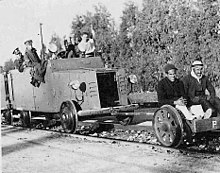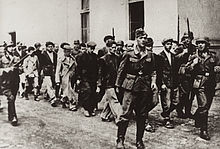hostage taking
A hostage-taking is an offense against personal freedom and against the physical integrity of a natural person .
Criminological demarcation between hostage-taking and kidnapping
Criminologists speak of kidnapping when the victim's whereabouts are unknown, i. H. the victim was taken to a place known only to the perpetrator . On the other hand, the hallmark of a hostage situation is that the victim ( hostage ) is in a place known to the police and is prevented from leaving this place.
Criminal law
Hostage-taking in the context of wars
introduction

In the past, it often happened that hostages were taken in the course of armed conflicts in order to extort ransom money or to induce certain behavior on the part of the population.
First World War
After the beginning of the First World War , the general of the German army, Max von Schenckendorff , marched through neutral Belgium with his unit, the 64th Infantry Regiment . The company took hostages at every night's quarters , as attacks were feared. The hostages were released in the morning.
On August 1, 1914 , Germany declared war on Russia . The Russian associations withdrew from Kalisch . On August 2, the city was occupied by the German 155th Infantry Regiment from Ostrowo under the command of Major Preusker. The city had to pay a contribution of 50,000 rubles and host 20 hostages. (Details here )
Second World War

With the atonement order (888/41) General Field Marshal Wilhelm Keitel issued an order for the Wehrmacht High Command on September 16, 1941 to execute 50 to 100 civilians for every German soldier killed in an ambush. The Atonement Order resulted in hostage-taking among civilians (especially Communists , Jews and Gypsies ) and was an element of the Holocaust and Porajmos . The hostage-taking and killings committed under this order were judged and punished as hostage-taking and mass murders in the Nuremberg trial of the main war criminals , the trial of Generals in Southeastern Europe ( hostage murder trial ) and numerous other legal proceedings .
On August 21, 1941, the occupation soldier Alfons Moser was assassinated in Paris in the Barbès-Rochechouart metro station . After two further assassinations against occupiers, field commander Karl Hotz in Nantes and war administrator Hans Gottfried Reimers in Bordeaux , Hitler ordered the military commander Otto von Stülpnagel , who was in Berlin that day, to shoot 100 French hostages. Stülpnagel wanted to reduce the number because of concerns about possible political consequences. Shortly afterwards he had a total of 98 hostages shot in Nantes and Châteaubriant . At the request of Otto von Stülpnagel, Ernst Jünger wrote a memorandum on the hostage shootings.
Since the end of 1944, the " Reichsführer SS " Heinrich Himmler, in coordination with the head of the Reich Main Security Office (RSHA), Ernst Kaltenbrunner , let the most prominent political prisoners of the Nazi state from the German concentration camps first in the Dachau concentration camp and finally in Niederdorf in April 1945 Bring South Tyrolean Pustertal . The SS guards had orders not to let the prisoners come into enemy hands alive. Thanks to the courageous action of the Wehrmacht officer Wichard von Alvensleben , the prisoners , who were finally housed in the Hotel Pragser Wildsee, were freed by the US Army there on May 4, 1945 . The background: The Nazi leadership hoped to be able to defend the so-called Alpine fortress from Bavaria to Trentino against the advancing Allies . Himmler, who in the last weeks and months of the Nazi regime carried out his own secret diplomacy, primarily in the direction of the Americans, and Kaltenbrunner believed that they could use the hostages as a negotiating position with the Allies. There were a total of 139 so-called special prisoners from seventeen European nations and a group of clan prisoners . Among them were the former Austrian Chancellor Kurt von Schuschnigg with his wife and daughter, the former French Prime Minister Léon Blum with his wife, Hitler's former Reich Economics Minister Hjalmar Schacht , the British secret agent Sigismund Payne Best , the former Hungarian Prime Minister Miklós Kállay , the Commander-in-Chief of the Greek Army, General Alexandros Papagos , with his entire general staff, the French Bishop of Clermont-Ferrand , Gabriel Piguet , the Protestant pastor Martin Niemöller and family members of the Hitler assassin Colonel Claus Schenk Graf von Stauffenberg .
A German officer, Captain Wichard von Alvensleben , had learned of the prisoner transport and had the prisoners in Niederdorf freed from the power of the SS by a Wehrmacht raid on April 30, 1945. On the same day, the prisoners were brought to the nearby Hotel Pragser Wildsee , where they were cared for for around three weeks. The US Army arrived at the hotel on May 4, 1945. They led the convoy of inmates via Verona to Naples and the island of Capri . After numerous interrogations, the liberated were finally allowed to return home.
Chronicle of sensational hostage-taking
Hostage-taking by individual perpetrators
- On August 23, 2010, a Filipino ex-police officer hijacked a 25-person bus in Manila and demanded that he be reinstated as a police officer. After a subsequent eleven hour hostage situation, the situation escalated when the perpetrator began shooting at the hostages. During the subsequent storm by a task force, the perpetrator and eight hostages were killed.
- In December 1999, a 46-year-old Bosnian brought the branch manager of a security company and two employees into his power and dragged them from Würselen to a branch of the state central bank in Aachen . After almost 50 hours of hostage-taking and lengthy negotiations, the man was shot dead by police while trying to escape with a hostage in a vehicle provided.
- May 19, 1998 in Florida , USA : Around 200 security guards surrounded a gas station in Hernando County where 30-year-old Hank Earl Carr had taken a pregnant employee hostage. Carr had previously shot a four-year-old boy and killed three police officers on the escape before he stormed the store after a wild chase. The perpetrator then conducted telephone interviews with the local radio station WFLA, before letting the hostage go after around five hours and shooting himself.
- In June 1993, Robert Sedlacek, with a multiple criminal record, had robbed a financial institution in Vienna , shot a policeman while trying to escape and then holed himself up with three hostages in a fashion store. While trying to persuade Sedlacek to give up, the latter suddenly shot the police chief negotiator and committed suicide . The chief negotiator was able to leave the hospital on the same day as the projectile got stuck in the officer’s mobile phone. The hostages were also unharmed.
- In August 1986, a bank robber armed with firearms and explosives brought eleven people into his hands in Helsinki . During the subsequent escape with three of the hostages in a vehicle provided, the police tried to overpower the perpetrator at a gas station. Two of the hostages were able to flee, the perpetrator and a 25-year-old bank customer died in the explosive triggered by the perpetrator, and nine police officers were injured.
- In August 1973, a prisoner on release entered the credit bank at Norrmalmstorg in central Stockholm and took four hostages. After three days, the police drilled a hole in the roof through which they first inserted a camera. Two days later, gas was introduced into the bank through this hole, ending the drama. Nobody was harmed. It was one of the first criminal cases that the Swedish media reported live. As a result, the psychiatrist Nils Bejerot named a survival strategy for the hostages " Stockholm Syndrome ".
Mass hostage-taking (excluding aircraft hijackings )
See also
literature
- Markus Immel: The endangerment of life and limb through hostage taking (§§ 239a, 239b StGB). Berlin 2001, ISBN 3-428-10488-9 .
- Marko Brambach: Problems of the crime of extortionate kidnapping and hostage-taking . Berlin 2000, ISBN 3-428-09936-2 .
- Markus Rheinländer: Extortionate kidnapping and hostage-taking (§§ 239a, 239b StGB): A structural analysis . Münster 2000, ISBN 3-8258-4545-1 .
- Sonja Christine Nikolaus: On the facts of extortionate kidnapping and hostage-taking . Berliner Wissenschafts-Verlag, Berlin 2003, ISBN 3-8305-0536-1 .
- Bundeswehr Center for Inner Leadership Ed .: Hostage and Captivity 4/96 1st revised. Edition May 1997.
Web links
Individual evidence
- ↑ Wolfgang Benz , Barbara Distel (ed.): The place of terror . History of the National Socialist Concentration Camps. Volume 9: Labor education camps, ghettos, youth protection camps, police detention camps, special camps, gypsy camps, forced labor camps. CH Beck, Munich 2009, ISBN 978-3-406-57238-8 , p. 341 ff.
- ↑ Leon Poliakov, Josef Wulf: The Third Reich and its servants - documents . Verlags-GmbH Berlin-Grunewald, 1956, p. 350 ff.
- ↑ Walter Manoschek: Are you going to shoot Jews? In: War of Extermination - Crimes of the Wehrmacht 1941 to 1944 . Zweiausendeins, 1995, ISBN 3-86150-198-8 , p. 39 f.
- ↑ And then the general asked to dance . In: Der Spiegel . No. 51 , 1997 ( online - chronology of events).

